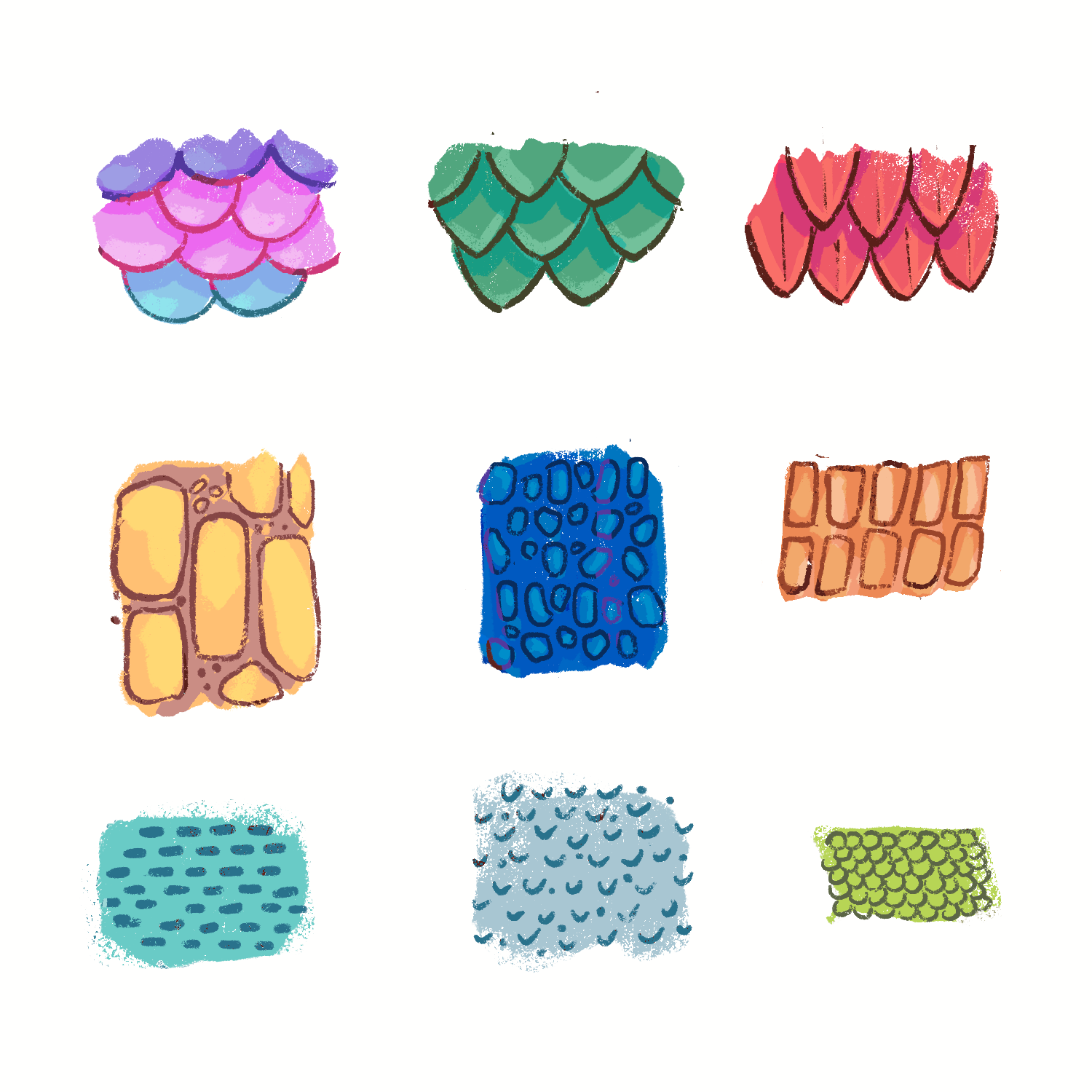Looking to make your dragons fierce, your mermaids magical, or a Tic-Toc Croc Neverland will never forget?
Scales can add an incredible amount of texture and realism to your drawings, and once you get the hang of it, they can be a lot of fun to create! I’ll sometimes choose to add a dragon to a drawing just for the chance to draw some scales.
Much like fur (which we went over last week) scales are a key design element you’ll encounter if you’re working on creature art, fantasy characters, or even illustrating magical armor. But getting them to look right—whether smooth, tough, or shiny—can be tricky.
With this tutorial, I’m hoping to make the process a little easier, and a little more fun!
So, without further ado…here’s everything you need to know about Scales!
Step 1: Start with the Base Shape
Just like when putting on a piece of jewelry over clothes, scales will layer over the base shape of your character.
So, the first step is to define the shape and form of the area where your scales will be placed.
Whether you're drawing a turtle, a snake, or even a mermaid, the underlying shape is essential to how your scales will lay across the body.
For example, for my newest Chinese Zodiac sticker collection, I drew a dragon!
Before I started on the scales, I needed to understand how they would sit on the body. This base shape is crucial because it determines how your scales will interact with the body’s form. Notice the rounded curves of the belly, the elongated tail, and the horns on its head? These will all affect how you place your scales in later steps.
Think about how the scales will wrap around curved surfaces like the tail or rest more flatly along areas like the chest or back. This planning stage helps you avoid any confusion once you start adding more details.
Step 2: Finding the Scale Pattern
The best way to think of scales is like puzzle pieces on a table; a repeated pattern, not all the same but all 'fitting' together. That's why the easiest shape to start with is repeating semicircles, or 'teardrops'.
Here’s how to break it down:
- First row: Draw a series of simple, rounded “U” shapes in a row.
- Second row: Offset the next row of “U” shapes, so that each one sits nestled between the tops of the scales from the first row.
- Third row: Continue this pattern downward until you’ve covered the area where scales will appear.
Now, you do not have to place these over the entire design! Putting just a few scattered shapes throughout can give the effect of having a scaled creature while keeping the design simpler and less busy.

You can see the effect this more scattered approach has on my dragon!
As you can see, there are only 12-ish individual scales throughout. But, because of their placement, it gives the whole body a scaled appearance!
Step 3: The Scale Types
When looking around at nature, and imagination, you’ll find thousands of unique, fascinating scale types. It makes sense: there are millions of unique animals out there!
Even mammals!
I will now temporarily halt this tutorial to introduce you to the “pangolin” because I think it is important you know about these magnificent creatures.

He’s just so polite. I love him.
Anyway, back to the art.
One of the best things you can do when working with scales is experiment with the shapes, sizes, and textures.
Smooth and Shiny Scales: These are the ones that come to mind when someone says “scales.” Common on fish, snakes, and reptiles; they’re flat and usually kept close to the body.

Rough and Bumpy Scales: For something tougher, like a crocodile or armadillo. The uneven spacing, creaks and cracks, give a bit more of a weathered, tough look.

Dot-Style Scales: Many animals (and fantasy creatures!) have extremely textured scales. Take a look at this close-up of iguana.

While the individual scales would actually be more pointed, like on the smooth and shiny scales, they’re tiny enough that they form this almost dot-like matrix.
Mix and match different scale shapes, sizes, and textures to suit the personality of your creature!
Step 4: Highlights and Shading
Once you have your scales drawn, it’s time to make them pop! Just like with fur, light and shadow play a huge role in making scales feel three-dimensional.
- Shading the Base: Begin by adding shadows between the scales, where they overlap. This will give them depth and make them appear more layered. You can add darker shading to the edges of each scale to make them look like they’re catching less light.
- Highlights for Shine: For scales that are meant to be sleek and shiny, add highlights along the top or side of the scales to show where the light hits them. This works especially well for fish or dragon scales that are meant to glimmer or sparkle.
- Texture Details: To enhance the rougher textures, add little scratches, nicks, or rough spots in the darker areas of your scales. Adding subtle lines and imperfections gives them a worn, battle-ready look.
Wrapping it All Up!
And there you have it! Scales don't have to be an overwhelming endeavor —once you break it down into manageable steps, it becomes much more approachable (and fun!).
Remember, scales come in many shapes and sizes, so don’t be afraid to experiment with patterns, colors, and textures to fit your characters. Whether you’re crafting a mighty dragon, a serene fish, or a your rogue adventurer's new armor, scales can be just what you need to bring your creation to life.
Oh, and if you'd like to see some more examples of scales (plus get to own the dragon that so kindly volunteered as our example today) you can pick up my full Chinese Zodiac sticker pack!
Check them out here!










1 comment
Love the tips! thank you for sharing! :) It’s always difficult to figure out how much is too much. Thank you for showing that simplicity is sometimes the best way.